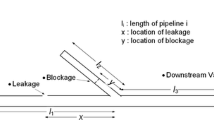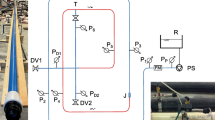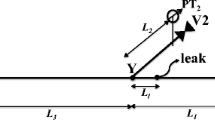Abstract
Transient analysis of multi-branched pipeline systems is generalized by the development of an impedance method. Both open and closed boundaries of branched pipeline elements were implemented in the analytical development of a reservoir multi-branched pipeline valve system, in which impedance and transient responses performance were compared with those of conventional approaches. To address realistic boundary conditions along the branched element, a partially opened boundary condition was implemented in the impedance expression of the branched pipeline system. The performance of the generalized multi-branch impedance method was evaluated on a large water supply system with 10 minor branches from the actual system. The impact of the designated branches was evaluated using the pressure root-mean-square error (RMSE) and the energy spectral density difference between the original and skeletonized systems. Combinations of multiple branches for certain flow conditions were identified based on the holistic response for both the frequency and time domains. The proposed method can be a useful alternative to effectively address the skeletonization issue for pipeline systems with multi-branched elements.







Similar content being viewed by others
Availability of Data and Materials
The supporting data are available from the corresponding author upon reasonable request.
References
Bettaieb N, Guidara MA, Taieb EH (2020) Impact of metallic-plastic pipe configurations on transient pressure response in branched WDN. Int J Press Vessels Pip 188. https://doi.org/10.1016/j.ijpvp.2020.104204
Brown FT (1962) The transient response of fluid lines. J Basic Eng 84(4):547–553
Brunone B, Golia UM, Greco M (1991) Some remarks on the momentum equations for fast transients. Hydraulic transients with column separation 9th and last round table of IAHR Group, IAHR, Valencia, Spain, 201–209
Capponi C, Ferrante M, Zecchin AC, Gong ZJ (2017) Leak Detection in a Branched System by Inverse Transient Analysis with the Admittance Matrix Method. Water Resour Manage 31(13):4075–4089. https://doi.org/10.1007/s11269-017-1730-6
Chaudhry MH (2014) Applied hydraulic transients. 3rd ed. Springer
Duan HF (2018) Accuracy and sensitivity evaluation of TFR method for leak detection in multiple-pipeline water supply systems. Water Resour Manage 32(6):2147–2164. https://doi.org/10.1007/s11269-018-1923-7
Duan HF, Lee PJ (2015) Transient-based frequency domain method for dead-end side branch detection in reservoir pipeline valve systems. J Hydraul Eng 142(2). https://doi.org/10.1061/(ASCE)HY.1943-7900.0001070
Evangelista S, Leopardi A, Pignatelli R, de Marinis G (2015) Hydraulic transients in viscoelastic branched pipelines. J Hydraul Eng 141(8):040150116. https://doi.org/10.1061/(ASCE)HY1943-7900.0001030
Huang T, Duan HF, Zhao M, Zhang Q, Zhao H, Zhang K (2017) Probabilistic analysis and evaluation of nodal demand effect on transient in urban water distribution system. J Water Resour Plan Manag 143(8):04017041. https://doi.org/10.1061/(ASCE)WR.1943-5452.0000797
Jung BS, Boulos PF, Wood DJ (2007) Pitfalls of water distribution model skeletonization for surge analysis. J Am Water Works Assoc 99(12):87–98. https://doi.org/10.1002/j.1551-8833.2007.tb08109.x
Keramat A, Duan HF, Pan B, Hou Q (2022) Gradient-based optimization for spectral-based multiple-leak identification. Mech Syst Signal Process 171(8):108840. https://doi.org/10.1016/j.ymssp.2022.108840
Kim S (2016) Impedance method for abnormality detection of a branched pipeline system. Water Resour Manag 30(3):1101–1115. https://doi.org/10.1007/s11269-015-1213-1
Kim S (2020) Multiple leak detection algorithm for pipe network. Mech Syst Signal Process 139(13):106645. https://doi.org/10.1016/j.ymssp.2020.106645
Liu MY, Yang J, Zheng W, Fan ED (2021) Using novel complex-efficient FastICA blind deconvolution method for urban water pipe leak localization in the presence of branch noise. J Water Resour Plan Manag 147(10):04021072. https://doi.org/10.1061/(ASCE)WR.1943-5452.0001453
Meniconi S, Brunone B, Frisinghelli M (2018) On the role of minor branches energy dissipation, and small defects in the transient response of transmission mains. Water 10(2). https://doi.org/10.3390/w10020187
Meniconi S, Cifrodeli M, Capponi C, Duan HF, Brunone B (2021a) Transient response analysis of branched pipe systems toward a reliable skeletonization. J Water Resour Plan Manag 147(2):04020109. https://doi.org/10.1061/(ASCE)WR.1943-5452.0001319
Meniconi S, Capponi C, Frisinghelli M, Brunone B (2021b) Leak detection in a real transmission main through transient tests: deeds and missdeeds. Water Resour Res 57(3). https://doi.org/10.1029/2020WR027838
Mpesha SL, Gassman MH, Chaudhry MH (2001) Leak detection in pipes by frequency response method. J Hydraul Eng 127(2):134–147
Pan B, Duan HF, Keramet A, Meniconi S, Brunone B (2022a) Efficient pipe burst detection in tree-shape water distribution networks using forward-backward transient. Water Resour Res 58(11). https://doi.org/10.1029/2022WR033465
Pan B, Capponi C, Meniconi S, Brunone B, Duan HF (2022b) Efficient leak detection in single and branched polymeric pipeline systems by transient wave analysis. Mech Syst Signal Process 162. https://doi.org/10.1016/jymssp.2021.108084
Funding
This work was supported by (2022R1A4A5028840) from the National Research Foundation of the Republic of Korea.
Author information
Authors and Affiliations
Contributions
Sanghyun Kim contributed to the study conception, design, analysis, and paper draft.
Corresponding author
Ethics declarations
Ethical Approval
Not applicable.
Consent to Participate
Not applicable.
Consent to Publish
Not applicable.
Competing Interests
The author has no relevant financial and non-financial interests to disclose.
Additional information
Publisher's Note
Springer Nature remains neutral with regard to jurisdictional claims in published maps and institutional affiliations.
Appendix
Appendix
The analytical impedance formulation (AIF) for the unsteady friction model under laminar flow conditions can be developed from existing studies (Brown 1962; Kim 2020). If the boundaries for multi-branched systems are closed, the hydraulic impedance of the nth number of branched pipeline elements can be generalized as follows:
where the propagation constant is \({\Gamma }_{xj}=s{x}_{j}/({a}_{j}\sqrt{1-2{J}_{1}(\frac{i{D}_{j}}{2\sqrt{\frac{s}{\upsilon }}})/(i{D}_{j}/2\sqrt{\frac{s}{\upsilon }}{J}_{0}(i{D}_{j}/2\sqrt{s/\nu )}}\)), and the characteristic impedance is \({Z}_{si}={a}_{i}/(g{A}_{i}\sqrt{1-2{J}_{1}(\frac{i{D}_{i}}{2\sqrt{\frac{s}{\upsilon }}})/(i{D}_{i}/2\sqrt{\frac{s}{\upsilon }}{J}_{0}(i{D}_{i}/2\sqrt{s/\nu )}}\), s is the frequency, \({\mathrm{D}}_{i or j}\) is the diameter of the element number subscript i or j, i is an imaginary unit, and J0 and J1 are first-type Bessel functions of the zero and first orders, respectively.
If the boundaries for multi-branched systems are open, the hydraulic impedance can be expressed as follows:
and
for odd and even numbers of upstream branched elements, respectively.
The AIF formulation for the unsteady friction model under turbulent flow conditions can be developed from models of instantaneous accelerations (Brunone et al. 1991; Kim 2020). If the boundaries for multi-branched systems are closed conditions, the hydraulic impedance downstream of the branched pipeline element, subscript db, can be generalized as follows:
where \({Zcx}_{1}=-{Z}_{cxu1}{Z}_{cxu2}{e}^{{\Upsilon }_{xu1}{x}_{u}}+{Z}_{cxu1}{Z}_{cxu2}{e}^{{-\Upsilon }_{xu2}{x}_{u}},\) \({Zcx}_{2}={Z}_{cxu2}{e}^{{\Upsilon }_{xu1}{x}_{u}}+{Z}_{cxu1}{e}^{{-\Upsilon }_{xu2}{x}_{u}}\), \({Zxc}_{3}={Z}_{cyb2}{e}^{{\Upsilon }_{yb1}{y}_{b}}+{Z}_{cyb1}{e}^{{-\Upsilon }_{yb2}{y}_{b}}\), \({Zcx}_{4}={e}^{{\Upsilon }_{yb1}{y}_{b}}-{e}^{{-\Upsilon }_{yb2}{y}_{b}}\), \({Zcx}_{5}=-{Z}_{cxd1}{Z}_{cxd2}{e}^{{\Upsilon }_{xd1}{x}_{d}}+{Z}_{cxd1}{Z}_{cxd2}{e}^{{-\Upsilon }_{xd2}{x}_{d}}\), \({Zcx}_{6}={Z}_{cxd1}{e}^{{\Upsilon }_{xd1}{x}_{d}}+{Z}_{cxd2}{e}^{{-\Upsilon }_{xd2}{x}_{d}}\), \({Zcx}_{7}={Z}_{cxd2}{e}^{{\Upsilon }_{xd1}{x}_{b}}+{Z}_{cxd1}{e}^{{-\Upsilon }_{xd2}{x}_{b}}\), and \({Zcx}_{8}={e}^{{\Upsilon }_{xd1}{x}_{d}}-{e}^{{-\Upsilon }_{xd2}{x}_{d}}\). Here, the propagation constants \({\Upsilon}_{l1}\) and \({\Upsilon}_{l2}\) can be defined as \({\Upsilon}_{l1, l2}=(\mp mCs+\sqrt{(mCs{)}^{2}+4({s}^{2}CL+RCs)})/2\); \(\mathrm{m}={(a}_{l}{k}_{2})/(2g{A}_{l})\); the capacitance as \(C=(g{A}_{l})/{{a}_{l}}^{2}\); the inertance as \(\mathrm{L}=(1+{k}_{1})/(g{A}_{l})\); the resistance per unit length as \(R=(f\overline{Q })/(g{D}_{l}{{A}_{l}}^{2})\) for turbulent flow; and the characteristic impedances as \({Z}_{cl1},{Z}_{cl2}=\frac{{\Upsilon }_{l1}}{Cs},\frac{{\Upsilon }_{l2}}{Cs}\) where subscript l represents corresponding pipeline elements (e.g., xu, xd, and yb represent the upstream section, downstream section, and branched element, respectively).
If the boundaries for multi-branched systems are open conditions, the downstream hydraulic impedance of the branched pipeline element, subscript db, can be generalized as follows:
where \({Zox}_{1}=-{Z}_{cxu1}{Z}_{cxu2}{e}^{{\Upsilon }_{xu1}{x}_{u}}+{Z}_{cxu1}{Z}_{cxu2}{e}^{{-\Upsilon }_{xu2}{x}_{u}}\), \({Zox}_{2}={Z}_{cxu2}{e}^{{\Upsilon }_{xu1}{x}_{u}}+{Z}_{cxu1}{e}^{{-\Upsilon }_{xu2}{x}_{u}}\), \({Zoc}_{3}={{Z}_{cyb1}Z}_{cyb2}{e}^{{\Upsilon }_{yb1}{y}_{b}}-{{Z}_{cyb1}Z}_{cyb2}{e}^{{-\Upsilon }_{yb2}{y}_{b}}\), \({Zox}_{4}={Z}_{cyb1}{e}^{{\Upsilon }_{yb1}{y}_{b}}+{Z}_{cyb2}{e}^{{-\Upsilon }_{yb2}{y}_{b}}\), \({Zox}_{5}=-{Z}_{cxd1}{Z}_{cxd2}{e}^{{\Upsilon }_{xd1}{x}_{d}}+{Z}_{cxd1}{Z}_{cxd2}{e}^{{-\Upsilon }_{xd2}{x}_{d}}\), \({Zox}_{6}={Z}_{cxd1}{e}^{{\Upsilon }_{xd1}{x}_{d}}+{Z}_{cxd2}{e}^{{-\Upsilon }_{xd2}{x}_{d}}\), \({Zox}_{7}={Z}_{cxd2}{e}^{{\Upsilon }_{xd1}{x}_{b}}+{Z}_{cxd1}{e}^{{-\Upsilon }_{xd2}{x}_{b}}\), and \({Zox}_{8}={e}^{{-\Upsilon }_{xd2}{x}_{d}}-{e}^{{\Upsilon }_{xd1}{x}_{d}}\).
Further formulations to multiple downstream branches and main sections can be developed from Eqs. (25) and (26).
Rights and permissions
Springer Nature or its licensor (e.g. a society or other partner) holds exclusive rights to this article under a publishing agreement with the author(s) or other rightsholder(s); author self-archiving of the accepted manuscript version of this article is solely governed by the terms of such publishing agreement and applicable law.
About this article
Cite this article
Kim, S.H. Generalized Impedance-based Transient Analysis for Multi-branched Pipeline Systems. Water Resour Manage 37, 1581–1597 (2023). https://doi.org/10.1007/s11269-023-03445-9
Received:
Accepted:
Published:
Issue Date:
DOI: https://doi.org/10.1007/s11269-023-03445-9




